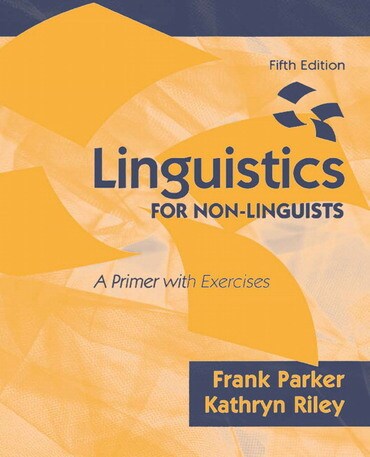
Linguistics for Non-Linguists: A Primer with Exercises, 5th edition
Published by Pearson (April 9, 2009) © 2010
- Frank Parker |
- Kathryn Riley |
Switch content of the page by the Role togglethe content would be changed according to the role
Title overview
- Hundreds of exercises distributed throughout the text, immediately after the concepts they are related to, help reinforce the material just learned.
- Supplementary Exercises at the end of each chapter provide additional opportunities to expand on the chapter material. Provides answers to selected exercises to help students check their work and offers an Instructor's Manual with Answer Key to all exercises.
- Filled with clear explanations, charts, tables, and illustrations.
- “Supplementary Readings” at the end of each chapter provide students with both classic and current resources about chapter concepts.
- New chapter on language change.
- Updated material throughout.
- Many new exercises, ranging from short-answer problems to suggestions for out-of-class projects.
- Updated “Supplementary Readings” providing additional information about each topic.
Table of contents
NOTE: Each chapter concludes with Summary, Supplementary Readings, Supplementary Exercises, and Exploratory Exercises.
1. Introduction
2. Pragmatics
- Implicature
- Conversational Maxims
- Speech Acts
- A Taxonomy of Illocutionary Acts
- Felicity Conditions
- Explicit Versus Nonexplicit Illocutionary Acts
- Direct Versus Indirect Illocutionary Acts
- Expressed Versus Implied Locutionary Acts
- Literal Versus Nonliteral Locutionary Acts
- Overview of Speech Act Theory
3. Semantics
- Background
- Sense
- Reference
- Truth
4. Syntax
- Categories
- Left-to-Right Ordering
- Constituent Structure
- X-Bar Syntax
- Transformations
- Movement
- Constraints on Movement
5. Morphology
- Morphemes
- Lexical and Grammatical Morphemes
- Free and Bound Morphemes
- Inflectional and Derivational Morphemes
- Inflectional Affixes
- Derivational Affixes
- Differences Between Types of Affixes
- Word-Formation Processes
6. Phonology
- Vocal Tract
- Segments
- Phonemic Alphabet
- Vowels
- Consonants
- Levels of Representation
- Phonological Rules
- Aspiration
- Vowel Lengthening
- Vowel Nasalization
- Flapping
- Rule Ordering
7. Language Processing
- Sentence-Level Phenomena in Language Processing
- Resolving Syntactic Ambiguity
- Resolving Ambiguous Pronoun Reference
- Understanding Negative Sentences
- Processing Passive Sentences
- Processing Complex Sentences
- Processing Heavy NPs
- Discourse-Level Phenomena in Language Processing
- Readability
- Schemata and Scripts
- Cohesion
- Thematic Roles
- The Given-New Contract
- Reading Between the Lines
8. Language Variation
- Language Universals, Languages, Dialects, and Idiolects
- Regional Variation
- Regional Lexical Variation
- Regional Phonological Variation
- Social Variation
- Nonstandard Phonological Variation
- Nonstandard Morphological Variation
- Nonstandard Syntactic Variation
- Language and Gender
- Gender as a Social Variable
- Gender Patterns Within Standard English
- Stylistic Variation
- Stylistic Lexical Variation
- Stylistic Phonological Variation
- Stylistic Morphological Variation
- Stylistic Syntactic Variation
9. Language Change
- Background
- Semantic Change
- Syntactic Change
- Word Order Typology
- Rule Change
- Morphological Change
- Phonological Change
- Causes of Change
10. First-Language Acquisition
- Prelinguistic Stages
- Linguistic Stages
- Acquisition of Phonology
- Acquisition of Morphology
- Acquisition of Syntax
- Acquisition of Semantics
- Issues in Language Acquisition
- Nativism and Empiricism
- Language-Specific and General Cognitive Capacities
- Chomsky’s Position
11. Second-Language Acquisition
- Issues in Second-Language Acquisition
- Interlanguage Theory
- Language Transfer
- Other Linguistic Factors
- Patterns in Second-Language Acquisition
- Phonology
- Morphology
- Syntax
- Semantics
- Nonlinguistic Influences on Second-Language Acquisition
12. Written Language
- Writing Systems
- The English Spelling System
- Reasons for Inconsistency in English Spelling
- English Spelling and Morphophonemics
- Analyzing Errors in Written English
- Phonology and Spelling
- Morphology and Writing
13. The Neurology of Language
- Anatomy of the Nervous System
- Lobes
- Convolutions and Fissures
- Broca’s Area
- Wernicke’s Area
- Supplementary Motor Cortex
- Hemispherical Specialization
- Left-Hemisphere Dominance for Language
- Left Brain Versus Right Brain
- Handedness
- Aphasia
References
Glossary
Answers to Selected Exercises
Author Index
Subject Index
